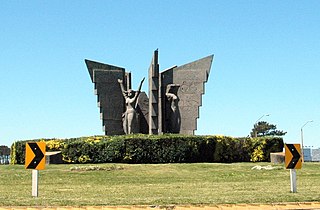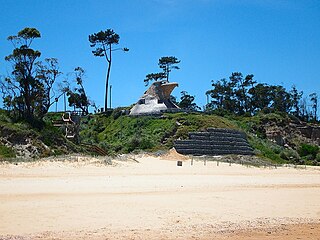Cuchilla Alta is a seaside resort of the Costa de Oro, in Canelones Department of Uruguay, Montevideo.
La Floresta is a city and resort on the Costa de Oro of the Canelones Department in Uruguay.

Ciudad de la Costa is a city in Canelones Department of Uruguay, on the banks of the Río de la Plata between the streams Arroyo Carrasco and Arroyo Pando. It is considered an extension of the metropolitan area of Montevideo which it borders to the west, while to the east it borders Costa de Oro. It was declared a city on 19 October 1994 and given its current name. At the 2011 census, it was the second most populated city of Uruguay between Montevideo and Salto.

Atlántida is a resort town of the Costa de Oro in Canelones Department of Uruguay, 45 kilometres (28 mi) east of Montevideo.
Costa de Oro is a 45 kilometres (28 mi) long group of resort towns and beaches in Canelones Department, Uruguay, east of the Ciudad de la Costa. Until 19 October 1994 it also included all the resorts that became henceforth integrated under the name Ciudad de la Costa. Since then, Costa de Oro contains only the resorts and locations of the area delimited by the streams Arroyo Pando to the west and Arroyo Solís Grande to the east and by the highways Ruta 8 and Ruta 9 to the north.

El Pinar is a seaside resort of the Canelones Department, Uruguay. In 1994, when Ciudad de la Costa took on the status of a city, El Pinar was incorporated in it.

Solymar is a coastal resort or residential neighbourhood of the Ciudad de la Costa in the Canelones Department of Uruguay. Its name is a contraction of the words "Sun and Sea".
Costa Azul is a village and resort of the Costa de Oro in the Canelones Department of southern Uruguay.
Las Toscas is a resort of the Costa de Oro in the Canelones Department of southern Uruguay.
Marindia is a resort of the Costa de Oro in the Canelones Department of southern Uruguay.

Neptunia is a resort town of the Costa de Oro in the Canelones Department of southern Uruguay.

Salinas is a city and resort of the Costa de Oro in the Canelones Department of southern Uruguay.
San Luis is a village and resort of Costa de Oro in the Canelones Department of southern Uruguay.

Villa Argentina is a resort (balneario) of the Costa de Oro in the Canelones Department of southern Uruguay. The famous eagle-shaped house overlooking the Río de la Plata, which is attributed to Atlántida, is in fact located in this resort.

Zagarzazú or Balneario Zagarzazú is a resort village in the Colonia Department of southwestern Uruguay.

Lomas de Solymar, which also contains the area Médanos de Solymar, is a residential neighbourhood and a resort of Ciudad de la Costa in Canelones, Uruguay.

Lagomar is a residential neighbourhood and resort of Ciudad de la Costa in Canelones, Uruguay.
Pinamar – Pinepark is a resort town of the Costa de Oro in the Canelones Department of southern Uruguay.
Biarritz is a village and resort of the Costa de Oro in the Canelones Department of southern Uruguay.
Argentino, also known as Balneario Argentino, is a village and seaside resort of the Costa de Oro in the Canelones Department of southern Uruguay.










